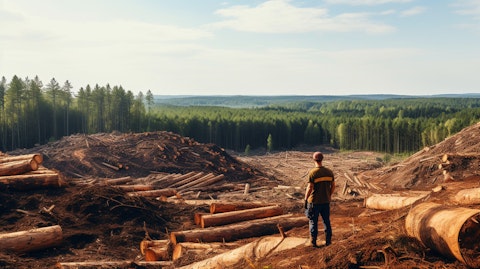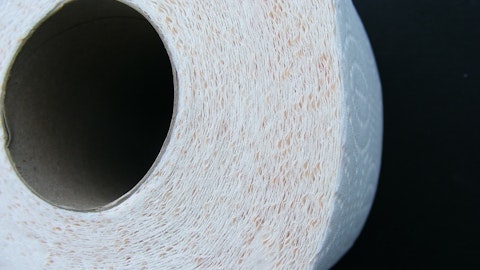Mercer International Inc. (NASDAQ:MERC) Q3 2023 Earnings Call Transcript November 3, 2023
Operator: Good morning, and welcome to Mercer International’s Third Quarter 2023 Earnings Conference Call. On the call today is Juan Carlos Bueno, Mercer’s President and Chief Executive Officer; and Richard Short, Mercer’s Chief Financial Officer and Secretary. I will now hand the call over to Richard.
Richard Short: Good morning, everyone. Thanks for joining us today. I will begin by touching on the financial and operating highlights of the third quarter, before turning the call over to Juan Carlos to provide further color into the markets, our operations, and our strategic initiatives. Also, for those of you that have joined the call by telephone, there is a presentation material that we have attached in the investor section of our website. Before turning to our results, I would like to remind you that we will be making forward-looking statements in this morning’s conference call. According to the safe harbor provisions of the Private Securities Litigation Reform Act of 1995, I would like to call your attention to the risks related to these statements, which are more fully described in our press release and in the company’s filings with the Securities and Exchange Commission.
This quarter, our EBITDA was $38 million compared to Q2’s negative EBITDA of $69 million, this significant improvement over the prior quarter was due to lower fiber and other production costs. Inventory impairment reversal and fewer days of scheduled annual maintenance downtime, partially offset by lower pulp sales realizations. Our pulp segment contributed quarterly EBITDA of $49 million, and our solid wood segment EBITDA was negative $7 million. You can find additional segment disclosures in our Form 10-Q, which can be found on our website, and that of the SEC. In Q3, our pulp segment had significantly lower fiber costs than Q2. As a reminder, Q2 results included a $51 million inventory impairment, primarily for hardwood. At the end of Q3, only about $9 million of this impairment remains against our closing inventory.
Our solid wood segment also had lower per unit fiber cost in Q3, when compared to Q2, due to the availability of lower cost beetle damaged wood in Germany. We currently expect beetle damaged wood to be available into 2024. In Q3, both our NBSK and NBHK sales realizations decreased compared to Q2 as modestly higher prices in China, driven by low customer inventory levels, were more than offset by lower prices in Europe and North America due to weak paper demand. Late in the quarter, we started to see similar restocking efforts in both Europe and North America, which created modest upward pricing pressure. In China, Q3 average NBSK net price was $680 per tonne, up $12 relative to Q2. It is worth noting that pulp prices in China are up about $100 a tonne compared to their low point this year.
European NBSK list prices averaged $1,160 per tonne in the current quarter, a decrease of $87 per tonne from Q2. The market price gap between NBSK and NBHK in China narrowed to about $150 per tonne in Q3 from $185 per tonne in Q2. In China, the Q3 average NBHK net price was $530 per tonne, up $47 compared to the average of Q2. The North American average Q3 list price was $1,023 per tonne, down $254 or about 20% from Q2. All our mills ran well this quarter, and we had less scheduled downtime in Q3, when compared to Q2. In Q3, we had a total of 39 days of downtime at our mills, which consisted of 13 days for planned maintenance and 26 days for logistics-related curtailment. While in Q2, we had 60 days of downtime at our mills, which consisted of 25 days for planned maintenance and 35 days for market curtailment.
The lower scheduled maintenance downtime positively impacted EBITDA by about $10 million in Q3, when compared to Q2. After adjusting for planned shuts and curtailments, pulp production was down approximately 12,000 tonnes from the second quarter. Total pulp sales volumes in the third quarter were about 487,000 tonnes, down about 9% from the second quarter due to the timing of sales. For our solid wood segment, modest lumber pricing improvements in the U.S. market were offset by lower pricing in the European market. Despite the price increases in the U.S., overall lumber demand remains weak due to high interest rates. The Random Lengths U.S. benchmark for Western SPF #2&Btr was $407 per thousand board feet at the end of Q3, compared to $380 at the end of Q2.
Today, the benchmark is around $377. We are not anticipating significant improvements to lumber pricing in a near-term due to high interest rates and the seasonal slowdown in construction activity. Lumber production was about 94 million board feet in the quarter, down almost 23% from Q2 due to scheduled annual maintenance work completed in Q3. Lumber sales volumes were approximately 115 million board feet, down 14% from the prior quarter. Electricity sales totaled 254 gigawatt-hours in the quarter, which is modestly up from Q2 due to fewer days of scheduled downtime in Q3. Pricing in Q3 increased to about $113 per megawatt-hour from $106 in Q2 due to modestly higher prices in both Germany and Canada. Our mass timber business continues to ramp-up operations resulting in revenue of $19 million in Q3 compared to $14 in Q2.
This business also has a growing order book that we expect to fulfill over the coming months. All-in-all, we reported a consolidated net loss of $26 million for the third quarter or $0.39 per share compared to a net loss of $98 million or $1.48 per share in Q2. Cash generated in the quarter totaled $130 million compared to cash used of $87 million in Q2. In Q3, cash generated from the senior note offering and positive EBITDA was offset by a higher net working capital balance primarily due to the timing of tax and interest payments, despite a reduction in inventory levels. Looking ahead, we expect a modest working capital reduction in Q4 due to further reductions in finished goods and raw material inventories. In Q3, we invested about $37 million of capital in our mills and, looking ahead, we currently expect capital spending to be about $140 million in 2023.
In September, we took important steps to enhance Mercer’s liquidity position to ensure strong liquidity through the business cycle. These steps included completing a private offering for $200 million of senior notes due in 2028 as well as increasing the availability of our German revolving credit facility by about €70 million to €370 million. The new 2028 senior notes carrying interest rate of 12.875%. At the end of Q3, our liquidity position totaled $648 million, comprised of $344 million of cash and about $305 million of undrawn revolvers. And as you would have noted from our press release, our board has approved a quarterly dividend of $0.075 per share for shareholders of record on December 20, for which payment will be made on December 28.
That ends my overview of the financial results. I’ll now turn the call over to, Juan Carlos.

Juan Carlos Bueno: Thank you, Rich. Good morning, everybody. Financially, Q3 was significantly better than our second quarter. Our production costs, including fiber, all trended down this quarter. Lower costs combined with modest price increases in some of our markets led to a significantly improved EBITDA result. And, although, the markets where we operate are still at historically low levels, surprising and have relatively weaker demand than expected, we’re seeing some selective modest recovery, but varying by geography. As a result of uncertain market conditions, we have taken proactive actions throughout this year to reduce our planned CapEx as we had already signaled in the previous quarter, and now expect to land at around $140 million for the full year.
At the same time, we continuous our focus on cost saving measures and aggressively managing our inventories during this third quarter, and we will continue this financial discipline, while our markets remain weak. I am pleased with our efforts to increase our liquidity this quarter. Our $200 million senior note private placement and the €70 million increase to our German revolving credit facility leave us well positioned to continue to execute our strategic plan through this business cycle. We’ve recognized that these 2028 senior notes come with a high cost at 12.875%, but given the depth and uncertainty around this down cycle in our markets, we felt it prudent to ensure Mercer has strong liquidity through this cycle. It is also important to note that the investments we have made in our solid wood segment over the last year, namely the acquisition of Torgau and Structurlam were primarily done with our own cash, and in the fullness of time these investments are expected to provide returns well in excess of the cost of these new notes.
Overall, pulp markets remain weak, but all markets appear to have hit their floors with modest price increases implemented in either Q3 or early Q4. For NBSK, these increases appear to be the result of paper producer restocking, a reaction that is likely due to the realization that softwood pulp supply is down roughly 1 million tonnes on an annualized basis between mill closures, conversions, and curtailments. Most of these tons are permanently removed from the market, which will positively impact pulp markets when demand begins to improve. On the demand side, European paper producers continue to run at reduced capacity rates, as the European economy remains weak, plus it continues to deal with the effects stemming from the Ukraine war. Similarly, in China, the government is pursuing measured economic stimulus steps, but weak economic growth continues in lights of significant risks faced by the real estate industry.
Looking forward, we expect pulp prices to continue to slowly increase in Europe and North America in Q4, as reduced supply supports moderate price improvements. As a result of the logistical issues created by the recent British Columbia port strike, we were forced to take a temporary 26-day curtailment at our Celgar mill during the month of August. This was not a decision we made lightly, but was necessary to manage the finished goods inventory at the mill. And we used this time to renegotiate our fiber supply contracts and are now seeing the benefits of it as our wood costs have come down, and this is already visible in our results. Our mills run very well in the quarter of the logistics-related curtailment at Celgar, resulting from this port issue negatively impacted pulp production relatively to the second quarter.
Our scheduled maintenance was down from 25 days, or roughly 25,000 tonnes in Q2 to only 13 days in Q3, all concentrated in a very well-executed shut at Rosenthal, reducing 30,000 tonnes of production as planned. Now, for this fourth quarter, our annual maintenance schedule includes Stendal taking a short 3-day shut that will include all the final repairs to the woodyard’s conveyor systems that was damaged by the fire in Q3 of last year; and Celgar taking a major 26-day maintenance in Q4 are roughly 41,000 tonnes of production in total. Moving to our solid wood segment, our third quarter results reflected mixed markets, particularly in lumber, with the U.S. market being up slightly on average, while the European market was down compared to Q2.
High interest rates continued to weigh on housing starts, which are expected to keep lumber prices range bound through Q4. We continue to believe that low lumber channel inventories, the large number of sawmill curtailments, relatively low housing stock. Wood shortages created by recent Canadian forest fires and constructive homeowners’ demographics are still very strong fundamentals for the construction industry and this will put positive pressure on the supply demand balance of this business in the mid-term. We will continue to optimize our mix of lumber products and customers to current market conditions. As such in Q3 slightly less than half of our lumber sales volumes were sold in the U.S., substituting volumes that otherwise would be destined for Europe and other markets.
The integration of Torgau continues to progress well. Other shipping pallet markets remain weak on the back of a weak European economy overall, while heating pallets prices were up roughly 20% due to seasonal demand relative to Q2. Once the European economy begins to show signs of recovery we expect pallet prices to return to normal levels, allowing this asset to deliver significant shareholder value to the sale of pallets and increased lumber sales. In addition, the integration of the Structurlam assets continues to progress as planned. We now have roughly 35% of North American mass timber production capacity, a broader range of product offerings, and a much larger geographic footprint, which gives us competitive access to the entire North American market.
We continue to see strong customer interests in our mass timber products, which has made our order files stronger, and including now several large marquee projects that we’re very proud of. Moving on to costs of fiber, overall, we experienced a decrease in hardwood prices in Q3. In Germany, a steady supply of sawmill chips resulted in cost decreases, but work done at our Canadian mills, including the ramp-up of Peace River’s woodroom and the renegotiation of contrasts in Celgar, push our fiber costs down in Q3. Looking ahead, we expect further modest declines in hardwood costs at all of our mills in Q4. Our new lignin extraction pilot plant continues its ramp-up as planned. As a reminder, this new lignin plant is a large step towards Mercer being able to begin commercialization of Lignin.
We’re excited about the future prospects of this product as a sustainable alternative to fossil fuel based products, such as in adhesives and advanced battery elements, who only name a few. This aligns perfectly with a strategy which involves expanding into green chemicals and products that are compatible with a circular carbon economy. As the world becomes more sensitive to reducing carbon emissions, we believe that products like lignin, mass timber, green energy, lumber and pulp will play increasingly important roles in displacing carbon intensive products, products like concrete and steel for construction or plastic for packaging. Furthermore, the potential demand for sustainable fossil fuels substitutes is very significant and has the potential to be transformative to the wood products industry.
We are committed to our 2030 carbon reduction targets and believe our products form part of the climate change solution. In fact, we believe that in the fullness of time, demand for our low carbon products will dramatically increase as the world looks for solutions to reduce its carbon emissions. We remain bullish on the long-term value of pulp and are committed to better balance our company through faster growth in our lumber and mass timber businesses. In closing, looking forward to Q4, we will remain focused on our cost reduction, CapEx and working capital initiatives, while we navigate the spirit of low pulp and lumber prices. We will continue to work on rebalancing our assets in line with the execution of our strategic plan and will continue to manage our cash and liquidity prudently.
Thanks for listening, and I will now turn the call back to the operator for questions. Thanks.
See also 11 Best Uranium Stocks To Buy and 11 Best Oil Refinery Stocks To Buy.
Q&A Session
Follow Mercer International Inc (NASDAQ:MERC)
Follow Mercer International Inc (NASDAQ:MERC)
Operator: Thank you. [Operator Instructions] Our first question comes from Hamir Patel with CIBC. You may proceed.
Hamir Patel: Hi, good morning. Juan Carlos, how much longer would you expect to benefit from the cheaper beetle wood in Europe? And, longer-term, how do you think about the risks to fiber availability just given how the beetle played out in British Columbia?
Juan Carlos Bueno: Yeah. Thank you, Hamir. We have a very important issue and one that we’re following very closely for obvious reasons. We believe that the beetle infestation would support lower prices for wood throughout most of 2024. And that’s what we’ve dialed-in into our estimates already thinking about what next year would look like. So not only Q4, but a large majority of 2024 should be benefiting by the impact of beetle infestation. Having said that, obviously, we monitor very closely how the whole access to wood or fiber in Europe has progressed. And this is something that we keep on in our radar, one of the things that we take advantage of is our Mercer Holz entity allows us to supply wood from all around Europe in a very efficient way. So we keep on putting a lot of emphasis on making sure that we maintain that differentiator from our side on fiber supply, while we monitor the evolution of these beetle infestation.
Hamir Patel: Fair enough. Thanks, Juan Carlos. And just a last question I had for Rich. How are you thinking about CapEx for 2024 and what are the larger growth projects that you’d expect to advance next year?
Richard Short: Yeah. So, I think we’re still going to have a pretty subdued CapEx plan for next year. So it’s not a lot of strategic initiatives. And, I think we’re going to sort of see how the year plays out. But it’ll be on the lower end, probably in $100 million neighborhood, I think, at this point.
Hamir Patel: Great. That’s all I had. I’ll turn it over. Thank you.
Operator: Thank you. One moment for questions. Our next question comes from [Sean Stewart] [ph] with TD Securities. You may proceed.
Unidentified Analyst: Thank you. Good morning. Juan Carlos, you mentioned the restocking efforts that are happening in pulp, in China, and I guess I’m wondering your assessment of how much of this is just inventory arbitrage and buying aggressively at the bottom versus actual consumption. It feels like paper markets in China are necessarily strong, so be interested in your perspective on the sustainability of price momentum we’re seeing right now.
Juan Carlos Bueno: Thank you, Sean. Yes, what you say is absolutely correct. I would say there’s a little bit of both. I wouldn’t attribute to only one of these factors. I think that there is some increase in consumption in China from just on the sake of the new plants that have been put up both in tissue and paper that are obviously demanding pulp. What I see the weakness though is in the actual market for those products from that point onwards. So while pulp might be consumed, the marketing of those paper products, I think, it will take longer than it usually does. On the other side of the spectrum, in fact, as you started your question, we do believe that there’s a lot of arbitrage of inventory going on and that’s why we remain cautious about any increases right now out of China.
We see that in Europe and in North America things are picking up, so they are obviously lower than China right now. So they have still space to pick up along the quarter. But I wouldn’t be overly optimistic about China prices developing much stronger until we really see some demand kicking in. Now, having said that, since the NBSK supply equation is in our view so tight, with so many curtailments happening, and so many closures of different mills. We do believe that if there is a reaction from a demand side, particularly in Europe, that has been very dormant, or even North America, we could see that that could be a catalyst for a real recovery in prices. But as everybody knows, it’s not clearly in the picture nowadays, when Europe or North America would start picking up strong momentum.
So we’ll have to see, we’re very cautious about pricing for the next few quarters.
Unidentified Analyst: Thanks for that detail. That’s helpful. Second question, it does seem like Torgau is an ongoing drag on results of the wood product segment. You touched on pallet markets. Any thoughts on repositioning of the product mix, which is something you talked about before? Does that take a backseat until you have clarity on broader balance sheet improvement for the company? How is the thinking evolved with respect to changing the product mix of Torgau?
Juan Carlos Bueno: Yeah, very important matter. When you look at Torgau, one of the things that we are doing, since pallet prices are very depressed historically, based on the fact that Europe is very little is moving in Europe right now from an economic perspective, things are very, very slow. Based on that, what we’ve done since we have capacity installed to produce pallets, we have rearranged our product portfolio and have changed a little bit more in the type of pallets that we’re able to produce and which markets we can serve them into open new markets for some of them and go for the higher value markets for us. That’s a little bit of what we’ve done behind the scenes on the pallet market. We’ve kind of made changes to all the sales organizations that we had or that Torgau had prior to our acquisition.
That’s been one change from our end with the existing footprint. On the other hand, we have started some of the transformation projects in Torgau, so that we can significantly take advantage of the capacity that the mill can offer from a lumber perspective. Some of those projects we’ve kind of put on the back burner for the time being. We know that once we restart them, they will soon be into fruition. So as you will have said, we’re cautiously looking at how the market develops, how our cash flow and our liquidity evolves. So that we can trigger the continuation and finalize those transformative projects for Torgau, which would give us the advantage, obviously, of a much larger production of lumber. It wouldn’t make a whole lot of sense to produce a whole lot of lumber right now at the current prices, but we do want to be ready when the prices pick up, and therefore us having a larger capacity to produce higher volumes of lumber by then.
Unidentified Analyst: That’s great. I appreciate the detail. That’s all I have.
Operator: Thank you. One moment for questions. Our next question comes from Matthew McKellar with RBC. You may proceed.
Matthew McKellar: Hi, good morning. Thanks for taking my questions. I’d like to stick with the palette market to start with. Should we be looking just to a general economic recovery in Europe as we think about what could kind of cause recovery in the pallet markets or given the Torgau is one of the larger facilities in Europe is likely EBITDA negative and the pallets have finite lives, could that market begin to tighten even absent a broader economic recovery?
Juan Carlos Bueno: Matthew, we do believe that this is very much linked to Europe’s economy not moving. When you think about pallets, it’s all about commerce, it’s all about shipping products here and there. And, basically, when you look at Germany overall, Germany being one of the most important economies in Europe is probably the one that has suffered the most and it’s actually going under our recession. So we do believe that only when we see some recovery from an economic perspective, GDP overall in Europe, we will see an immediate move towards a higher use of pallets and therefore with higher demand, we would expect higher prices. So that’s really what we believe we’re up against and that’s where all kind of our chips based on that premise, which we believe hold very true.



